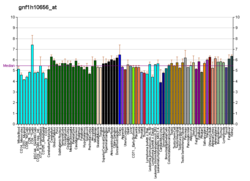| OR2T6 |
|---|
|
| Identifiers |
|---|
| Aliases | OR2T6, OR2T6P, OR2T9, OST703, olfactory receptor family 2 subfamily T member 6 |
|---|
| External IDs | MGI: 3030554; HomoloGene: 74036; GeneCards: OR2T6; OMA:OR2T6 - orthologs |
|---|
| Gene location (Human) |
|---|
 | | Chr. | Chromosome 1 (human)[1] |
|---|
| | Band | 1q44 | Start | 248,375,746 bp[1] |
|---|
| End | 248,391,811 bp[1] |
|---|
|
| Gene location (Mouse) |
|---|
 | | Chr. | Chromosome 14 (mouse)[2] |
|---|
| | Band | 14|14 A1 | Start | 8,282,925 bp[2] |
|---|
| End | 8,298,025 bp[2] |
|---|
|
| RNA expression pattern |
|---|
| Bgee | | Human | Mouse (ortholog) |
|---|
| Top expressed in | - gonad
- anterior cingulate cortex
- human kidney
|
| | Top expressed in | - respiratory epithelium
- nasal epithelium
- olfactory epithelium
|
| | More reference expression data |
|
|---|
| BioGPS |  | | More reference expression data |
|
|---|
|
| Gene ontology |
|---|
| Molecular function | - G protein-coupled receptor activity
- olfactory receptor activity
- signal transducer activity
| | Cellular component | - integral component of membrane
- plasma membrane
- membrane
| | Biological process | - sensory perception of smell
- signal transduction
- response to stimulus
- detection of chemical stimulus involved in sensory perception of smell
- G protein-coupled receptor signaling pathway
| | Sources:Amigo / QuickGO |
|
| Orthologs |
|---|
| Species | Human | Mouse |
|---|
| Entrez | | |
|---|
| Ensembl | |
|---|
ENSG00000198104
ENSG00000278689
ENSG00000278659 |
| |
|---|
| UniProt | | |
|---|
| RefSeq (mRNA) | | |
|---|
| RefSeq (protein) | | |
|---|
| Location (UCSC) | Chr 1: 248.38 – 248.39 Mb | Chr 14: 8.28 – 8.3 Mb |
|---|
| PubMed search | [3] | [4] |
|---|
|
| Wikidata |
| View/Edit Human | View/Edit Mouse |
|

















